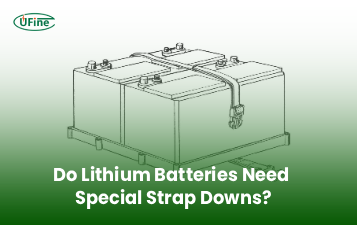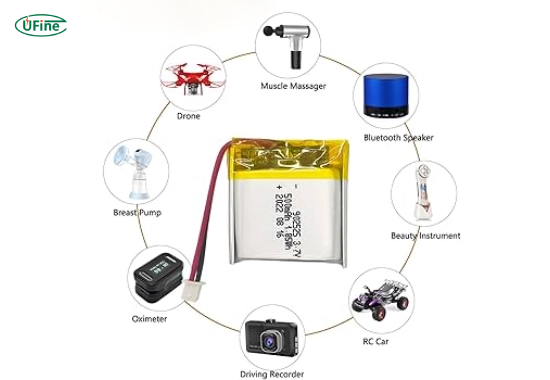
- Part 1. What does 500mAh mean in a battery?
- Part 2. What types of devices use a 500mAh battery?
- Part 3. How long does a 500mAh battery last in practice?
- Part 4. Is 500mAh enough for your product?
- Part 5. Can 500mAh batteries be recharged reliably?
- Part 6. How long does it take to charge a 500mAh lithium battery?
- Part 7. How to extend the life of a 500mAh battery?
- Part 8. Differences between 500mAh and other battery capacities
- Part 9. How to choose the right 500mAh lithium battery for your product?
- Part 10. Safety considerations for 500mAh lithium batteries
- Part 11. FAQs about 500mAh battery
What does a 500mAh battery mean, and why should device manufacturers care about it?
A 500mAh battery refers to a battery with a capacity of 500 milliampere-hours, indicating the total charge it can store. This capacity plays a critical role in determining how long a device can operate before needing a recharge. For businesses that develop small electronic devices, understanding what 500mAh means in practical terms is essential in product design, user satisfaction, and supply chain decisions.
As a lithium battery manufacturer, we frequently collaborate with B2B clients across various industries, including wearable devices, medical equipment, sensors, and consumer electronics. This article is designed to serve as a technical yet accessible guide to the 500mAh battery, helping businesses understand its applications, capabilities, limitations, and how to choose the right specification for product integration.
Part 1. What does 500mAh mean in a battery?
When a lithium battery is rated at 500mAh, it means it can deliver 500 milliamperes of current for one hour before it is fully discharged. This is a standard way of describing battery capacity.
To put it in perspective:
- If a device consumes 500mA of power constantly, the battery will last 1 hour.
- If the device draws 250mA, the battery can last 2 hours.
- At 100mA consumption, the battery could last up to 5 hours.
In reality, runtime may vary slightly due to factors such as battery age, voltage, temperature, and internal resistance. However, the mAh rating offers a practical baseline for estimating power duration.
Part 2. What types of devices use a 500mAh battery?
The 500mAh lithium battery is most commonly used in compact, low-drain devices where minimal weight and size are important. These include:
- Wearable devices such as fitness trackers and smart bands
- Wireless audio products like compact Bluetooth earbuds
- Medical monitoring equipment such as portable ECG recorders
- Internet of Things (IoT) sensors for temperature, humidity, or location tracking
- Smart key fobs and access control devices
- Miniature drones and electronic toys
- Portable LED indicators
In each of these use cases, manufacturers prioritize mobility, form factor, and energy efficiency, which makes the 500mAh battery a suitable and reliable choice.
Part 3. How long does a 500mAh battery last in practice?
The actual runtime of a 500mAh battery depends on the current consumption of the device it powers. Below is a breakdown of typical device power consumption scenarios and the estimated runtime:
| Device/Application | Power Consumption (mA) | Estimated Runtime (500mAh) |
|---|---|---|
| Smart band (always on) | 50 mA | 10 hours |
| Bluetooth earbud (music) | 100 mA | 5 hours |
| IoT temperature sensor | 25 mA | 20 hours |
| Mini drone (in flight) | 300 mA | 1.6 hours |
| Smart lock (standby + unlock) | 5 mA avg | 100 hours |
These estimations assume the battery is in good condition and fully charged. In mass production environments, it is crucial to test and verify power consumption under real operating conditions to ensure optimal performance.
Part 4. Is 500mAh enough for your product?
Whether 500mAh is sufficient depends on your application. Here are some considerations:
- For low-power devices that operate intermittently or have optimized standby modes, 500mAh is often more than adequate.
- If your device requires continuous power draw above 200mA, the battery may need to be recharged frequently, or you may need a larger capacity to meet user expectations.
- For products requiring long standby time but short bursts of activity (such as a remote sensor pinging every 15 minutes), 500mAh can last several days or even weeks.
When selecting battery capacity during the product development stage, it is important to balance size, weight, cost, and runtime for best results.
Part 5. Can 500mAh batteries be recharged reliably?
Yes. Most 500mAh batteries used in modern devices are rechargeable lithium-ion (Li-ion) or lithium polymer (Li-Po) cells. These chemistries offer:
- High energy density in compact form
- Low self-discharge rates
- Long cycle life, typically over 300 to 500 full charge cycles
- Safe performance when manufactured and handled properly
For B2B clients, we recommend choosing batteries with integrated protection circuits (PCM) that guard against overcharging, over-discharging, and short circuits. This ensures safe charging and longer battery lifespan.
Part 6. How long does it take to charge a 500mAh lithium battery?
Charging time depends on the current provided by the charger. As an example:
- Charging at 500mA (1C rate) can fully recharge the battery in about 1 hour
- Charging at 250mA (0.5C rate) takes approximately 2 hours
- Charging at 100mA (0.2C rate) may take up to 5 hours
For safety and battery longevity, many manufacturers recommend a 0.5C to 1C charging rate. It’s important for product integrators to ensure chargers are certified and calibrated to match the battery’s specifications.
Part 7. How to extend the life of a 500mAh battery?
Battery longevity is a key concern in product design and customer satisfaction. Here are best practices for maximizing the usable life of a 500mAh lithium battery:
- Avoid full discharges. Keep battery levels between 20% and 80% when possible.
- Minimize exposure to heat. High temperatures accelerate battery degradation.
- Use optimized charging circuits that prevent overcharging and overheating.
- Implement low-power modes in software to reduce energy consumption during idle times.
- Store batteries partially charged (around 50%) if they are not going to be used for long periods.
These principles are especially important for B2B clients deploying large-scale devices in the field.
Part 8. Differences between 500mAh and other battery capacities
Different devices require different battery capacities based on their function and power draw. Below is a comparison of various capacities with specific runtime estimates based on a device consuming 100mA of current:
| Battery Capacity (mAh) | Typical Devices | Estimated Runtime (at 100mA) |
|---|---|---|
| 500mAh | Wearables, sensors | 5 hours |
| 1000mAh | Mini cameras, GPS trackers | 10 hours |
| 2000mAh | Smart speakers, bike lights | 20 hours |
| 3000mAh | Smartphones, handheld scanners | 30 hours |
| 5000mAh | Tablets, industrial tools | 50 hours |
| 10000mAh | Power banks, backup medical equipment | 100 hours |
This table provides a baseline estimate. Actual performance will vary depending on the device’s power profile, software efficiency, and battery quality. When working with enterprise clients, our engineering team often conducts custom simulations and sample testing to ensure proper sizing.
Part 9. How to choose the right 500mAh lithium battery for your product?
Choosing the right battery is not just about capacity. B2B clients should consider the following:
- Voltage: Most lithium cells operate at 3.7V nominal, but your device may require 3.6V or 3.8V depending on the circuit.
- Discharge current: How much current does your device draw at peak and continuous operation?
- Dimensions and shape: Does the battery physically fit your product’s design?
- Operating temperature range: Will the product be used in extreme climates?
- Cycle life: How many charge-discharge cycles before performance drops?
- Certifications: For international markets, batteries may need UN38.3, CE, RoHS, MSDS, or IEC62133 certifications.
Working with a reliable lithium battery manufacturer ensures that these specifications are met, and quality is consistent across batches.
Part 10. Safety considerations for 500mAh lithium batteries
Safety is paramount, especially when deploying large volumes of electronic devices to the market. Here are key safety practices:
- Use batteries with built-in protection circuitry
- Avoid mechanical damage to battery cells during assembly
- Do not expose batteries to high temperatures or moisture
- Use certified chargers that match the battery specifications
- Follow proper transportation and storage guidelines
As a lithium battery supplier, we offer custom solutions that meet international safety standards and can be integrated into your product design with full technical support.
Part 11. FAQs about 500mAh battery
Is a 500mAh battery right for industrial devices?
Yes, if the device has low power requirements or operates intermittently. For example, sensors or monitoring devices used in smart factories or agriculture often use batteries in the 300 to 1000mAh range.
Can I replace a 500mAh battery with a higher capacity one?
Yes, as long as the voltage, size, and connector type are compatible. A higher mAh rating will provide longer runtime, which may benefit the end user.
How many charge cycles can a 500mAh lithium battery handle?
On average, a well-made lithium battery can last 300 to 500 full cycles. Partial charging and discharging can extend this lifespan.
Can I fast charge a 500mAh battery?
Fast charging is possible if the battery supports it and has the appropriate PCM protection. However, for safety and longevity, charging at 0.5C to 1C rate is typically recommended.
Do 500mAh batteries require custom tooling?
Not necessarily. Many 500mAh lithium cells come in standard sizes. However, for embedded applications, custom shape or connector options are available upon request for OEM
Related Tags:
More Articles

Do Lithium Batteries Require Special Strap Downs? (Safety + Vibration Control)
Discover why lithium batteries require special strap downs to prevent vibration damage, terminal stress, and internal component issues.
Battery Strap Down Safety Tips: Preventing Vibration Damage and Terminal Stress
Follow these expert battery strap down safety tips to prevent vibration damage, terminal stress, and ensure LiFePO4 battery longevity.
How to Choose a Good 18650 Battery with Reliable Quality?
Battery quality defines performance and safety. Ufine Battery shares how to source good 18650 batteries and avoid unstable suppliers.
Can I Use a Universal Battery Strap Down on LiFePO4 Batteries? (Compatibility Guide)
Learn whether universal battery strap downs are compatible with LiFePO4 batteries, and how to install them safely for vibration control.
Battery Strap Down vs Battery Hold-Down Bracket: What’s the Difference?
Compare battery strap downs and hold-down brackets. Learn key differences, installation tips, and which is safer for lithium batteries.




